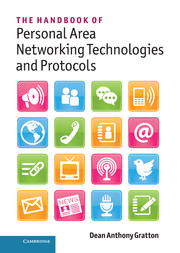Book contents
- Frontmatter
- Dedication
- Contents
- About the Author
- Making My Book Social
- Acknowledgements
- Before We Begin
- About This Book
- Part I What's In Your Area Network?
- Part II The Wireless Sensor Network
- Part III The Classic Personal Area Network
- 11 Introducing the Classic Personal Area Networking Technologies
- 12 Just Touch with NFC
- 13 The 802.11 Generation and Wi-Fi
- 14 Bluetooth Classic and High speed
- 15 One Standard, All Devices
- Part IV Forthcoming Technologies and Conclusions
- Glossary
- References and Bibliography
- Index
11 - Introducing the Classic Personal Area Networking Technologies
from Part III - The Classic Personal Area Network
Published online by Cambridge University Press: 05 September 2013
- Frontmatter
- Dedication
- Contents
- About the Author
- Making My Book Social
- Acknowledgements
- Before We Begin
- About This Book
- Part I What's In Your Area Network?
- Part II The Wireless Sensor Network
- Part III The Classic Personal Area Network
- 11 Introducing the Classic Personal Area Networking Technologies
- 12 Just Touch with NFC
- 13 The 802.11 Generation and Wi-Fi
- 14 Bluetooth Classic and High speed
- 15 One Standard, All Devices
- Part IV Forthcoming Technologies and Conclusions
- Glossary
- References and Bibliography
- Index
Summary
Mainstream wireless personal area networking capable consumer electronic products (excluding Infra-red (IR)) began to appear in the late 1990s and during the early 2000s the market witnessed the emergence of the first Wi-Fi and Bluetooth products. The ability to use products wirelessly was a completely new experience, as IR products required devices to be in line-of-sight. The TV remote control, of course, is the classic example of an IR device still commonly used today, although ZigBee, Bluetooth wireless technology, and a few others are looking to evolve this classic 40+ year old product. Nevertheless, the Motorola Xoom 2 (motorola.com) included IR capability to offer a universal remote, which can control multiple IR capable devices through a dedicated App, such as Dijit (dijit.com), a universal remote control application for smartphones and tablets. Another similarly classic wireless technology is the key-fob for vehicular access – it remains popular and doesn't require a line-of-sight operation. Some early wireless products that utilized Wi-Fi and Bluetooth were perhaps a cumbersome introduction to the wireless era, as many consumers grappled with early versions of these wireless-enabled products. The growth and development of these wireless devices as they have evolved has been exponential. The last decade or so has afforded consumers the ability to acclimatize to and increasingly become familiar with a range of wireless-enabled products and their associated idiosyncrasies, ensuring their future success. To demonstrate consumers’ over-familiarity with wireless technology, Wi-Fi has become synonymous with the ability to connect to the Internet; in fact, some consumers incorrectly regard Wi-Fi as the Internet.
Information
- Type
- Chapter
- Information
- Publisher: Cambridge University PressPrint publication year: 2013
